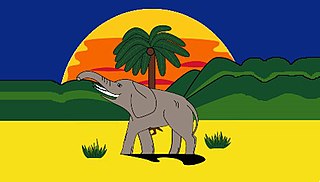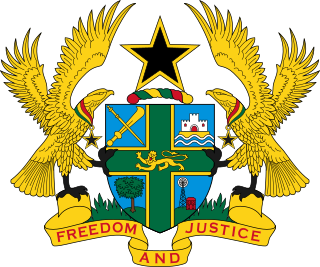The history of Togo can be traced to archaeological finds which indicate that ancient local tribes were able to produce pottery and process tin. During the period from the 11th century to the 16th century, the Ewé, the Mina, the Gun, and various other tribes entered the region. Most of them settled in coastal areas.. The Portuguese arrived in the late 15th century, followed by other European powers. Until the 19th century, the coastal region was a major slave trade centre, earning Togo and the surrounding region the name "The Slave Coast".

British Togoland, officially the Mandate Territory of Togoland and later officially the Trust Territory of Togoland, was a territory in West Africa, under the administration of the United Kingdom, which subsequently entered into union with Ghana, part becoming its Volta Region. It was effectively formed in 1916 by the splitting of the German protectorate of Togoland into two territories, French Togoland and British Togoland, during the First World War. Initially, it was a League of Nations Class B mandate. In 1922, British Togoland was formally placed under British rule while French Togoland, now Togo, was placed under French rule.

Togoland was a German Empire protectorate in West Africa from 1884 to 1914, encompassing what is now the nation of Togo and most of what is now the Volta Region of Ghana, approximately 90,400 km2 in size. During the period known as the "Scramble for Africa", the colony was established in 1884 and was gradually extended inland.

The decolonisation of Africa was a process that took place in the mid-to-late 1950s to 1975 during the Cold War, with radical government changes on the continent as colonial governments made the transition to independent states. The process was often marred with violence, political turmoil, widespread unrest, and organised revolts in both northern and sub-Saharan countries including the Algerian War in French Algeria, the Angolan War of Independence in Portuguese Angola, the Congo Crisis in the Belgian Congo, the Mau Mau Uprising in British Kenya, the Zanzibar Revolution in the Sultanate of Zanzibar, and the Nigerian Civil War in the secessionist state of Biafra.

Volta Region is one of Ghana's sixteen administrative regions, with Ho designated as its capital. It is located west of Republic of Togo and to the east of Lake Volta. Divided into 25 administrative districts, the region is multi-ethnic and multilingual, including groups such as the Ewe, the Guan, and the Akan peoples. The Guan peoples include the Lolobi, Likpe, Akpafu, Buem, and Nkonya people. This region was carved out of the Volta Region in December 2018 by the New Patriotic Party.

The Gold Coast was the name for a region on the Gulf of Guinea in West Africa that was rich in gold, petroleum, sweet crude oil and natural gas. This former region is now known as the country Ghana.
The Anlo Youth Organisation was a political party that existed in the Gold Coast and later Ghana. It campaigned for the Ewe people under British rule to stay within Ghana after independence. It ended by merging with other parties to form a united opposition to the Convention People's Party.

The strains in Ghana–Togo relations stretch back to pre-independence days.
The Togoland Congress (TCP; was a political party formed in 1951 which had won three seats in the Gold Coast elections of April 1954 and two seats in the July 1956 elections, but did not survive for long afterwards. The Togoland Congress's goal was to campaign for the unification of the Ewe people in British Togoland and French Togoland as a separate Ewe state; however the party yet again failed in the May 1956 UN plebiscite held in British Togoland, which had resulted in the unification of British Togoland and the Gold Coast.

This is a survey of the postage stamps and postal history of Togo.
A United Nations referendum was held in British Cameroons on 11 February 1961 to determine whether the territory should join neighbouring Cameroon or Nigeria. This followed an earlier plebiscite in Northern Cameroon in 1959 which voted to postpone a decision. The option of independence was not on the ballot, having been opposed by Andrew Cohen, the UK representative to the UN Trusteeship Council, as well as African and anti-colonial delegations, notably by E. M. L. Endeley, who favoured integration with Nigeria, and John Ngu Foncha, who favoured (eventual) reunification with Francophone Cameroon.

A referendum on autonomy was held in French Togoland on 28 October 1956. Since World War I, the territory had been a League of Nations mandate and then a United Nations Trust Territory under French control. The referendum offered residents the choice of remaining a Trust Territory or becoming an autonomous region within the French Union. The result was 93% in favour of the latter, with a 77.3% turnout. However, the referendum was rejected by the United Nations General Assembly as it had not included the option of independence and opted to continue with the trusteeship. In neighbouring British Togoland, a referendum earlier in the year had resulted in the territory becoming part of Ghana.

Western Togoland is an unrecognised state which is internationally recognised by the international community as a part of Ghana. It claims five the Volta and Oti Regions. In 25 September 2020 separatists in Western Togoland declared independence from the Republic of Ghana. Western Togoland has been a member state of the Unrepresented Nations and Peoples Organization (UNPO) since 2017.

The Ewe Unification Movement was a series of west African ethno-nationalist efforts which sought the unification of the Ewe peoples spread across what are now modern Ghana and Togo. It emerged as a direct political goal around 1945 under the colonial mandate of French Togoland, however the ideal of unifying the group has been an identifiable sentiment present amongst the ethnicity's leadership and wider population ever since their initial colonial partitions by the British and German Empires from 1874 to 1884. While there have been many efforts to bring about unification, none have ultimately been successful due to both the platform itself often being a secondary concern for political leadership, or inter/intrastate conflicts overshadowing them.

The Benin–Togo border is 651 km in length and runs from the tripoint with Burkina Faso in the north down to the Bight of Benin in the south.

The Ghana–Togo border is 1,098 km in length and runs from the tripoint with Burkina Faso in the north to the Atlantic Ocean in the south.

The Ghana Independence Act 1957 is an Act of the Parliament of the United Kingdom that granted the Gold Coast fully responsible government within the British Commonwealth of Nations under the name of Ghana. The Act received the Royal Assent on 7 February 1957 and Ghana came into being on 6 March 1957.

The Western Togoland Rebellion is an ongoing separatist revolt led by the Ewe nationalist organization Western Togoland Restoration Front against the government of Ghana. The group seeks the independence of former British Togoland.

The Political history of Ghana recounts the history of varying political systems that existed in Ghana during pre-colonial times, the colonial era and after independence. Pre-colonial Ghana was made up of several states and ethnic groups whose political system was categorized by 3 main administrative models; Centralized, Non-centralized and Theocratic states. In the colonial era, the British Empire employed different forms of government among its four territorial possessions in the Gold Coast. Indirect rule was implemented in the late 19th century after its success in Northern Nigeria. From the 1940s, native Ghanaians yearned for more autonomy. This resulted in the several constitutional reforms as well as the creation of the office of the Prime Minister in 1952.

France–Togo relations are the diplomatic relations between the French Republic and the Togolese Republic. Both nations are members of the Organisation internationale de la Francophonie and the United Nations.
















